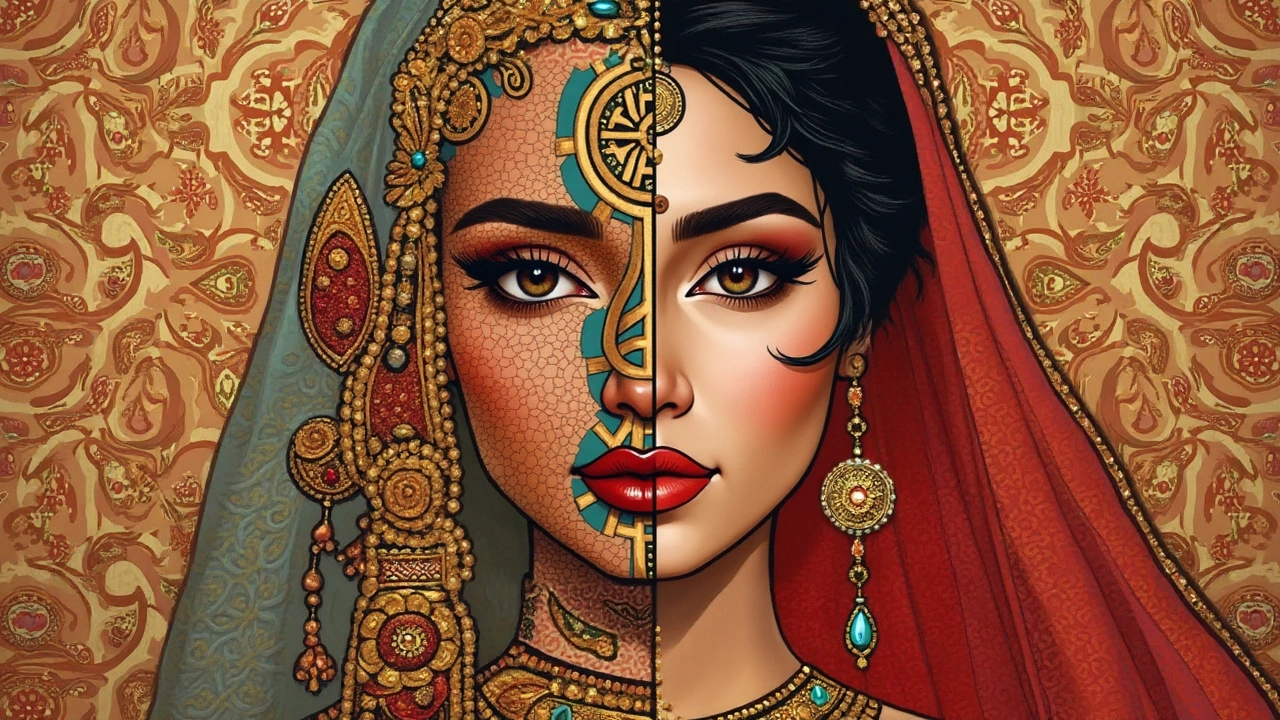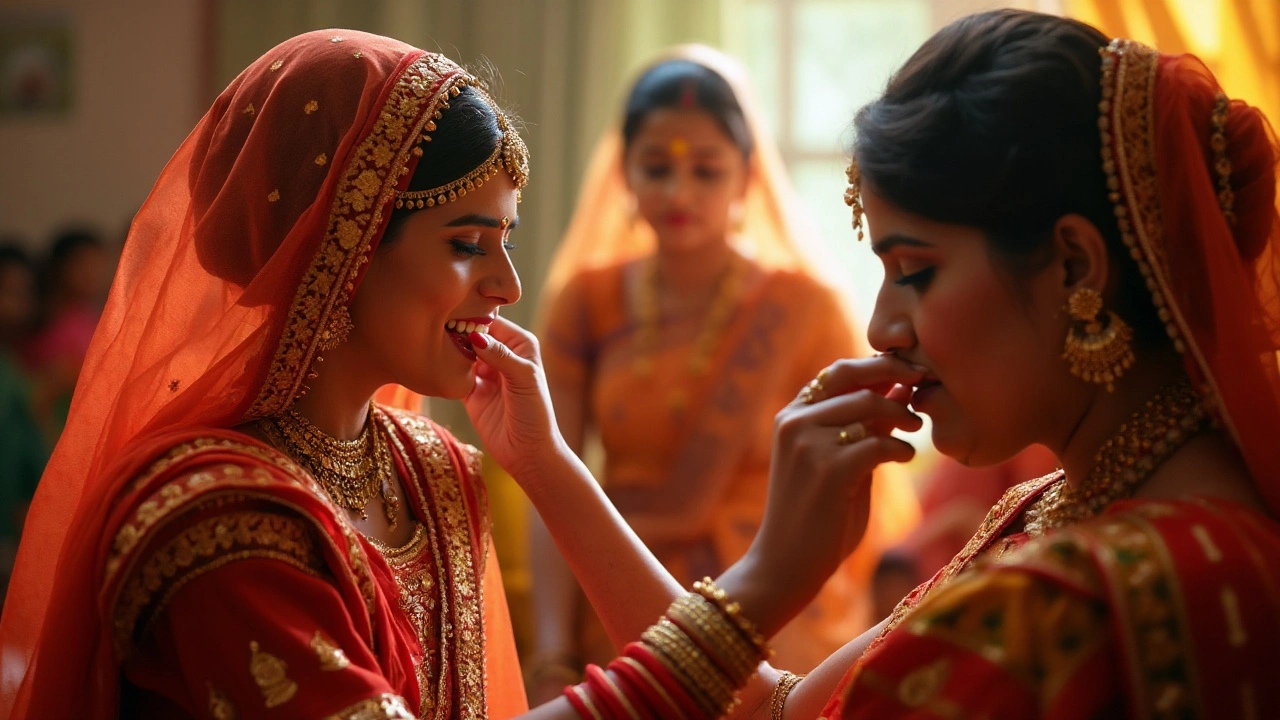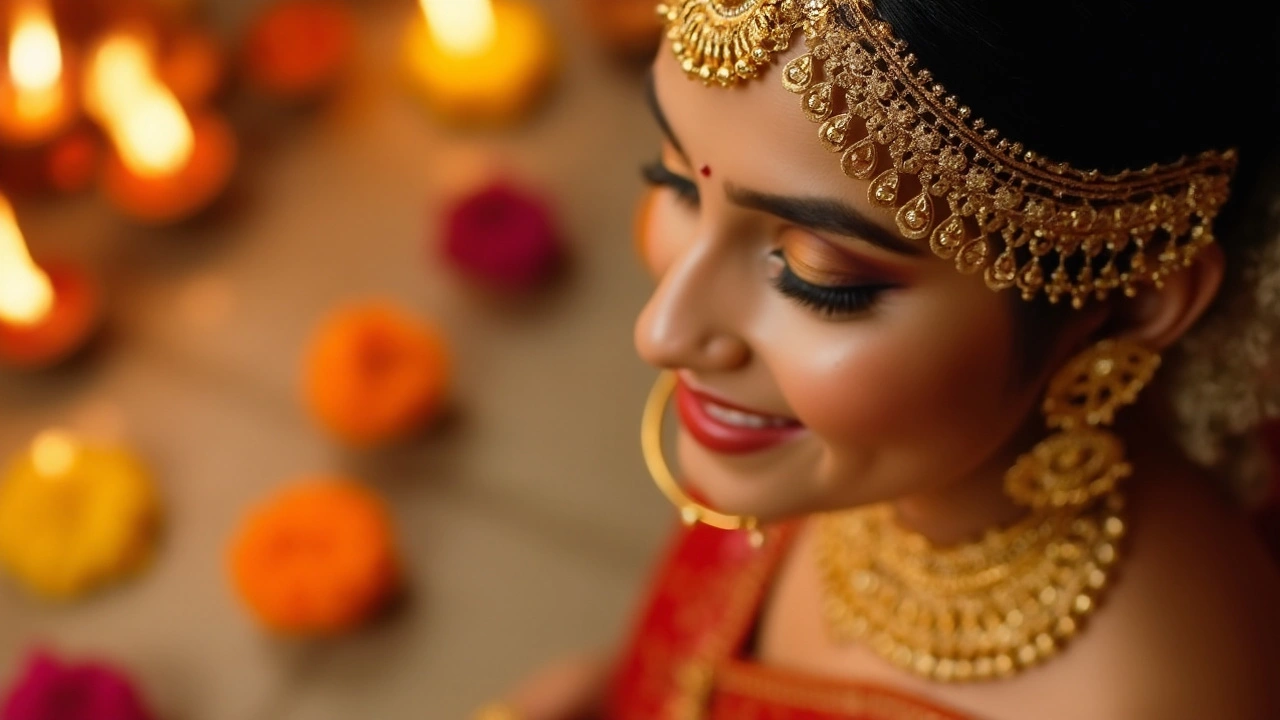India is a land rich with diverse cultures and enthralling traditions, each with its own distinct customs and symbols. One of the most captivating adornments in Indian weddings is the bridal nose ring, or 'nath.' This piece of jewelry isn't just an ornament; it's a part of the bride's identity, representing a myriad of cultural beliefs and social significances.
The bridal nose ring's origins are steeped in history, potentially tracing back to ancient Persian culture before spreading across the Indian subcontinent. Different regions in India have embraced and adapted this practice, each infusing their own local flavor and meaning. Throughout this exploration, we'll uncover the various customs and beliefs that make the nose ring a vital part of Indian matrimonial ceremonies and how its relevance persists in today's modern world.
Join us as we delve into this intricate tradition, learned from tales told by elders and passed through generations. Discover why despite modern influences, the nath remains a cherished symbol of grace and beauty, sustaining its legacy amidst evolving bridal trends.
- Historical Origins of the Bridal Nose Ring
- Cultural Significance Across Indian Regions
- The Symbolism of the Nose Ring in Marriage
- Modern Trends and Interpretations
- Choosing the Right Nose Ring for Your Wedding
Historical Origins of the Bridal Nose Ring
The origins of the bridal nose ring, or nath, as it is lovingly called in various parts of India, can be traced back to ancient times, reflecting a blend of cultural influences over centuries. It's believed that this adornment first made its way to Indian shores via the Mughals, who brought with them a tradition of ornate jewelry, including nose rings that were prevalent in Middle Eastern societies. Although the exact timeline is somewhat nebulous, historical texts suggest that the adoption of the nath occurred around the 16th century, coinciding with the Mughal Empire's expansion.
As with many symbols of cultural identity, the nose ring evolved to carry distinct meanings and styles across different Indian regions. In North India, larger and more elaborate designs, sometimes linked with a chain to the hair, became a mark of opulence, representing not just marital status but wealth and social standing as well. Meanwhile, in the Southern part of the country, where traditions have their own flavor, the nose ring took on a simpler form but no less in symbolic importance. It often reflected regional materials and designs, making it a testament to the diversity within Indian cultural practices.
According to a study by the Indian National Trust for Art and Cultural Heritage, "The nath stands as a symbol of beauty, femininity, and spiritual sanctity, transforming through ages yet retaining its intrinsic essence across communities."
Traditionally, the act of wearing a nose ring is tied to Ayurvedic beliefs. The piercing of the left nostril, which is commonly chosen for the bride's nath, corresponds to the female reproductive organs according to Ayurveda. This is thought to ease the discomfort of menstruation and childbirth, a notion deeply rooted in traditional Indian medicine. This unique blend of cultural, medical, and aesthetic values showcases the multifaceted symbol that the nose ring represents in Indian society. Indian bridal jewelry like the nose ring thus serves dual purposes, blending beauty with ancient cultural wisdom.
While the times have changed, making way for modern adaptations of this age-old custom, the emotional and symbolic fabric intertwined with such traditions holds strong. In urban weddings today, brides often choose to honor this historical significance with styles that reflect both timeless tradition and contemporary elegance. As families continue to pass down their stories connected to the nath, it remains evident that the historical roots of this cherished piece retain their relevance, bridging generational gaps in the ceremonial world of Indian weddings.
Cultural Significance Across Indian Regions
The nose ring, often known as the nath, holds a cherished place in Indian bridal jewelry, embodying not only beauty but profound cultural heritage that varies significantly across the vast Indian landscape. Within the northern plains, the nose ring is seen as a symbol of marital status and honor. In states like Punjab, brides traditionally don a heavy nath adorned with precious stones, reflecting familial wealth and status. Meanwhile, in the bustling cities of Maharashtra, the nath often carries a distinct crescent shape that symbolizes both prosperity and the influence of historical Maratha warrior queens.
As we journey further south, the cultural narrative shifts noticeably. In Kerala, a simpler form of the nose ring, known as the 'mukuthi,' is preferred, reflecting a blend of local customs and personal taste. Here, it's common for brides to embrace minimalist designs, which harmonize with both the natural beauty of the region and the serene yet colorful wedding attire. Tamil Nadu, another southern gem, showcases its unique spin by offering brides a variety of distinct nose ornaments, each signifying different familial customs and varying degrees of gold purity, which is deeply rooted in their Dravidian heritage.
"The beauty of India is in its variety, and the bridal nose ring is a testament to this incredible diversity," remarks culture historian Kavita Singh.
Heading eastward, Bengal introduces an entirely different flavor. The traditional Bengali bride might opt for a dainty nose pin called 'nathin,' which complements her elaborate red-and-white wedding attire. This choice underscores the combination of simplicity and elegance cherished by Bengali culture. In contrast, West Indian traditions, like those in Gujarat and Rajasthan, have brides wearing colossal nose rings, sometimes extending to the ear with elaborate chains. This particular style is thought to avert the evil eye and invite good fortune, drawing inspiration from the colorful and vibrant Marwari lifestyles.
Amidst these regional traditions, it's fascinating to note the influence of religious practices and historical changes. Different communities, whether Hindu, Sikh, Islamic, or others, carry forward their unique interpretations of what the nose ring represents. Across different faiths, the nose ring embodies blessings, fertility, and a long, harmonious marital life, highlighting its universal role in shaping a bride's journey. Despite the tide of modernization, the cultural significance of the Indian bridal nose ring holds steadfast, reiterating a collective nostalgia for the past and an enduring love for traditional rites.

The Symbolism of the Nose Ring in Marriage
Amidst the dazzling array of jewelry gracing an Indian bride, the nose ring holds a unique position of prominence. It is more than just an ornamental accessory; it carries deep-rooted connotations of matrimonial alliance and societal values. This article navigates the cultural tapestry of India, where the nose ring, known as 'nath,' stands out as a profound emblem of marital union and feminine elegance. As diverse as the country itself, various regions of India interpret its symbolism differently, yet it unifies under the theme of harmony and prosperity within marriage.
In many Indian traditions, the nose ring is believed to signify a woman's marital status and her entry into a new phase of life. A bride's donning of the nath often marks her transition into womanhood and symbolizes her newfound responsibilities. It is traditionally worn on the marriage day, and the customs surrounding it can vary significantly from one community to another, each with its own set of rituals and beliefs. In some cultures, the size and design of the nath are said to reflect the family's wealth and prestige, making it a symbol not only of personal but also familial honor.
"The nose ring's role in an Indian wedding is not just about aesthetics; it is deeply woven into the fabric of cultural identity," notes renowned historian Dr. Meera Chandrasekhar, emphasizing its iconic status in bridal traditions.
Historically, Ayurvedic traditions ascribe health benefits to the nose ring, too. It's said that the left nostril, where the nath is predominantly worn, is associated with the female reproductive organs. Hence, piercing it is believed to ease menstruation pains and aid childbirth—a testament to the blend of health and tradition in Indian customs. While such beliefs may vary in acceptance across different communities today, they underscore the intricate relationship between tradition and holistic practices inherent to Indian culture.
In contemporary times, though modern interpretations have resulted in the nath evolving in style and wearability, its fundamental meaning endures. Today, brides have a plethora of design choices, from ornate gold and diamond-encrusted pieces to simpler, understated options. This evolution in design reflects a balancing act between tradition and individual expression. Some brides may opt for detachable naths, which they can remove post-ceremony yet keep as cherished symbols of their wedding day. Despite these modern tweaks, the Indian bridal jewelry staple remains an enduring testament to its rich cultural heritage, echoing the sentiments of continuity and cultural pride.
Modern Trends and Interpretations
In recent years, the Indian bridal nose ring has seen a fascinating evolution, intertwining traditional roots with contemporary styles. As society embraces global influences, modern brides are personalizing the 'nath' in ways that reflect both their cultural heritage and individual tastes. This bespoke approach to bridal jewelry allows for a more personal statement, wherein the nose ring transforms from a mere cultural emblem to a symbol of personal expression. The contemporary scene has catalyzed designers to experiment with inventive designs, ranging from minimalist studs to ornate, gem-encrusted pieces that can weigh down even the stoutest of noses. These aren't merely visual choices; they reflect the modern bride's desire to respect customs while embracing the freedom of choice that characterizes the 21st century.
The dialogue between tradition and modernity can be observed in how different regions adapt the nose ring tradition for today's fashion-forward brides. For instance, in cosmopolitan cities like Mumbai and Delhi, you will often see younger brides opting for detachable rings or clip-ons, offering convenience without sacrificing style. This evolution is born partly from practicality, as the lifestyles of contemporary women demand flexibility. Moreover, the rise of mix-and-match culture in weddings has seen the nose ring being paired in unexpected ways – think Western-style wedding gowns accompanied by a traditional Indian 'nath' in a delightful contrast.
Gone are the days when nose rings were solely the domain of traditional family jewelers. Nowadays, young, innovative designers have entered the scene, offering an array of options that cater to diverse tastes and preferences. In a conversation with Vogue, renowned jewelry designer Ritu Kumar noted, "Today's brides are looking for pieces that are timeless, yet they also want something unique that reflects their own personal journey."
The cultural significance of these pieces remains untouched even as their designs evolve. The nose ring continues to be a potent symbol of marital bliss, often integrated into wedding ceremonies as a token of prosperity and commitment. Despite their modernized appearance, they still echo the whispers of generations gone by, tying the past with the present in an everlasting bond. It is this harmony between past and present that ensures the 'nath' maintains its pedestal in the panoply of Indian bridal jewelry. As trends ebb and flow, the essence of the bridal nose ring as a bridge between heritage and modernity keeps it timeless in the evolving landscape of wedding fashion.

Choosing the Right Nose Ring for Your Wedding
The journey of picking the perfect nose ring, or Indian bridal jewelry, for your wedding can be immensely joyous yet slightly overwhelming. With cultures so rich, the choices are abundant, from delicate diamond studs to extravagant gold hoops adorned with pearls and gemstones. First and foremost, consider the tradition of your specific cultural background. Different regions in India, from the picturesque landscapes of Kashmir to the sun-kissed shores of Kerala, have unique styles and motifs that carry specific meanings.
Your nose ring should echo your family's traditions while encapsulating your personal style. Delve into your familial heritage and perhaps ask your elders for anecdotes about the styles they cherished on their wedding day, as such stories can provide invaluable insight and inspiration. It's not uncommon for families to pass down heirloom pieces, apart from adding an emotional dimension, this intricately woven history in your nose ring serves as a tangible link between generations.
Factors to Consider
When choosing a nose ring, one must reflect upon the comfort and the practicality of the piece. Weddings can be long affairs, and a comfortable fit is paramount. Pay attention to the material used, such as gold, silver, or platinum, which complements your skin tone and bridal outfit. Additionally, consider the functional aspect of putting on the nose ring. Some designs require piercings, while others can be clipped on - a small but essential detail that can significantly affect your comfort during the special day.
An often overlooked aspect is how the nose ring interacts with other bridal jewelry. It's crucial to ensure a cohesive look where your nose ring enhances rather than clashes with your other accessories like earrings, necklaces, and maang tikka. If your bridal aesthetic leans towards minimalism, opt for a delicate piece that whispers elegance. Conversely, if grandeur is your vision, a bold, traditional nose ring tradition laden with intricate designs brings drama and allure to your ensemble.
A study conducted in 2022 found that over 65% of brides in Northern India chose to wear traditional large hoops adorned with chains that connect to the hair, a timeless style that speaks of both cultural roots and opulence.
"The rich tapestry of Indian culture is woven into every piece of bridal jewelry, particularly the nose ring, an emblem of tradition and personal expression," said renowned designer Sabyasachi.
Engage with your jeweler to customize the design to marry tradition with your personal touches. With technological advances in jewelry-making, many artisans offer design previews through sketches or digital renderings. Understanding how a design will sit on your face aids in making confident choices. During your wedding day, every glance at the mirror should remind you of how uniquely beautiful and culturally significant your chosen piece is.
